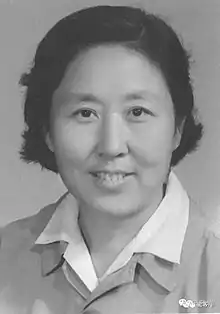The "Five Black Categories" (Chinese: 黑五类; pinyin: Hēiwǔlèi) were classifications of political identity defined during the period of the Chinese Cultural Revolution (1966–1976) in the People's Republic of China by Mao Zedong, who ordained that people in these groups should be considered enemies of the Revolution.
- Landlords (地主; dìzhǔ)
- Rich farmers (富农; fùnóng)
- Counter-revolutionaries (反革命; fǎngémìng)
- Bad influencers ["bad elements"] (坏分子; huàifènzǐ)
- Right-wingers (右派; yòupài)
Conversely, Mao categorized groups of people, such as members of the Chinese Communist Party, poor farmers and low class workers, as Five Red Categories.[1][2] This new Red/Black class distinction was used to create a status society.
Cultural Revolution

Starting from the "Red August" of 1966, people in the Five Black Categories were separated out for struggle sessions, humiliation, re-education, beating, and persecution.[2][4][5] Many of them were killed by the Red Guards and others.[3][4][6] Mao believed that victimizing these people, as well as other groups of citizens – such as teachers, educated intellectuals, and enemies of the Communist Party (cadres) – was a necessary component to initiate the changes in the Chinese culture that he desired. He believed that those who were victimized either deserved it or became better citizens as a result of it. In general, intellectuals were called the "Stinking Old Ninth". Effectively, within a few years, the education and medical infrastructure of China was completely destroyed.[7][8]
According to a speech by Jiang Qing, who was his wife and Party's senior leader, "If good people beat bad people, it serves them right; if bad people beat good people, the good people achieve glory; if good people beat good people, it is a misunderstanding; without beatings, you do not get acquainted and then no longer need to beat them" (Walder 149).
Members of the Black Classes were systematically discriminated against, as one's classification could affect employment opportunities and career prospects and even marriage opportunities. This could also be passed onto their children. Over time this resulted in a victimized underclass that was treated as if it were still composed of powerful and dominant people.[2][3][4][5][9]
See also
References
- 1 2 Sorace, Christian; Franceschini, Ivan; Loubere, Nicholas (2019-05-21). Afterlives of Chinese Communism. Verso Books. ISBN 978-1-78873-476-9.
- 1 2 3 4 Jian, Guo; Song, Yongyi; Zhou, Yuan (2006-07-17). Historical Dictionary of the Chinese Cultural Revolution. Scarecrow Press. ISBN 978-0-8108-6491-7.
- 1 2 3 Song, Yongyi (2011-08-25). "Chronology of Mass Killings during the Chinese Cultural Revolution (1966-1976)". Sciences Po. Retrieved 2019-11-30.
- 1 2 3 Wang, Youqin (2001). "Student Attacks Against Teachers: The Revolution of 1966" (PDF). The University of Chicago. Archived (PDF) from the original on 2020-04-17.
- 1 2 Gaskell, Ivan; Carter, Sarah Anne (2020-03-12). The Oxford Handbook of History and Material Culture. Oxford University Press. ISBN 978-0-19-934176-4.
- ↑ "A Massacre in Daxing County During the Cultural Revolution". Chinese Law & Government. 14 (3): 70–71. 2014-12-07. doi:10.2753/CLG0009-4609140370.
- ↑ Issues & Studies. Institute of International Relations, Republic of China. 1988.
- ↑ Bonavia, David (1989). Deng. Longman. ISBN 978-0-582-99952-7.
- ↑ Margolin, Jean-Louis. "Mao’s China: The Worst Non-Genocidal Regime?." In The historiography of genocide, pp. 438-467. Palgrave Macmillan, London, 2008, p.448
Further reading
- MacFarquhar, Roderick, John K. Fairbank, and Denis C. Twitchett, eds. "Mass Mobilization." The Cambridge History of China, Volume 15, The People's Republic Part 2. Revolutions within the Chinese Revolution, 1966–1982. 545. New York: Cambridge University Press, 1991. Print.
- WALDER, Andrew G. Fractured Rebellions: The Beijing Red Guard Movement. Cambridge: Harvard University Press, 2009. Print.
- Yongyi, Song. "Chronology of Mass Killings during the Chinese Cultural Revolution (1966-1976)." Online Encyclopedia of Mass Violence. 25 August 2011. Web. 31 March 2014.